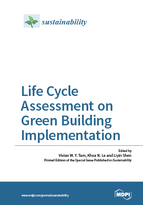Life Cycle Assessment on Green Building Implementation
A special issue of Sustainability (ISSN 2071-1050).
Deadline for manuscript submissions: closed (30 March 2016) | Viewed by 103790
Special Issue Editors
Interests: wireless communication; green building
2. School of Management Science and Real Estate, Chongqing University, Chongqing 400045, China
3. Department of Real Estate and Construction, University of Hong Kong, Hong Kong, China
Interests: green building; sustainable urbanization; low carbon city; city carrying capacity
Special Issues, Collections and Topics in MDPI journals
Interests: construction and project management; environmental management; sustainability; mega projects; sustainable construction; recycled concrete
Special Issues, Collections and Topics in MDPI journals
Special Issue Information
Dear Colleagues,
Greenhouse-gas emissions have become one of the most impacting environmental issues in today’s society. A rapidly increasing trend in global CO2 emissions particularly since the early nineties (23.64% since 1990) has led to the generation of about 50,000 million tons of CO2–equivalent (eqv) worldwide in 2010. According to mainstream climate experts, the increasing concentration of greenhouse-gases is having a warming effect on the world climate. To slow down global warming, there is a global focus on reducing greenhouse-gas emissions. Life cycle assessment in green building implementation is the focus of this Special Issue.
Dr. Vivian W. Y. Tam
Dr. Khoa N. Le
Prof. Liyin Shen
Guest Editors
Manuscript Submission Information
Manuscripts should be submitted online at www.mdpi.com by registering and logging in to this website. Once you are registered, click here to go to the submission form. Manuscripts can be submitted until the deadline. All submissions that pass pre-check are peer-reviewed. Accepted papers will be published continuously in the journal (as soon as accepted) and will be listed together on the special issue website. Research articles, review articles as well as short communications are invited. For planned papers, a title and short abstract (about 100 words) can be sent to the Editorial Office for announcement on this website.
Submitted manuscripts should not have been published previously, nor be under consideration for publication elsewhere (except conference proceedings papers). All manuscripts are thoroughly refereed through a single-blind peer-review process. A guide for authors and other relevant information for submission of manuscripts is available on the Instructions for Authors page. Sustainability is an international peer-reviewed open access semimonthly journal published by MDPI.
Please visit the Instructions for Authors page before submitting a manuscript. The Article Processing Charge (APC) for publication in this open access journal is 2400 CHF (Swiss Francs). Submitted papers should be well formatted and use good English. Authors may use MDPI's English editing service prior to publication or during author revisions.
Keywords
- green building
- life cycle assessment
- greenhouse gas emissions







